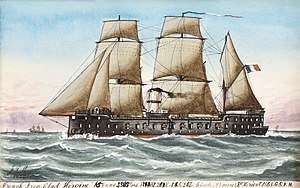French ironclad Héroïne
The French ironclad Héroïne was one of 10 Provence-class ironclads built for the French Navy during the 1860s. She was the only one of the Provence class to be built in iron.[1]
 Portrait of Héroïne in 1883, by James Scott Maxwell (1845-1922) | |
| History | |
|---|---|
| Name: | Héroïne |
| Namesake: | Hero (feminine form) |
| Ordered: | 16 November 1860[1] |
| Builder: | Lorient[1] |
| Laid down: | 10 June 1861[1] |
| Launched: | 10 December 1863[1] |
| Commissioned: | 7 June 1865[1] |
| Fate: | Scuttled off Dakar[1] |
| General characteristics (as completed) | |
| Class and type: | Broadside ironclad |
| Displacement: | 5,900–6,000 t (5,800–5,900 long tons) |
| Length: | 80.72 m (264 ft 10 in) |
| Beam: | 17 m (55 ft 9 in) |
| Draft: | 7.7–8.4 m (25 ft 3 in–27 ft 7 in) |
| Installed power: |
|
| Propulsion: | 1 shaft, 1 Horizontal-return connecting-rod steam engine |
| Sail plan: | Barque-rig |
| Speed: | 13–14.5 knots (24.1–26.9 km/h; 15.0–16.7 mph) |
| Range: | 2,410 nautical miles (4,460 km; 2,770 mi) at 10 knots (19 km/h; 12 mph) |
| Complement: | 579–594 |
| Armament: | 30 × single 164 mm (6.5 in) Mle 1858-60 breech-loading guns |
| Armor: |
|
Career
In 1870, at the outbreak of the Franco-Prussian War, Héroïne was part of the North squadron.[1] She blockaded the neutral harbour of Vigo, in Spain, where the German commerce raider SMS Augusta was resupplying. Héroïne arrived in mid-January 1871, and was reinforced by three more ships in the following days, trapping Augusta until the Armistice of Versailles of 28 January.[2][3]
In 1876, under Captain Sellier, she sailed to Thessaloniki after the Salonika Incident, where a mob assassinated the French and German Consuls in Thessaloniki on 6 May 1876.[1]
The Navy decommissioned Héroïne in 1883, and struck her form the lists in 1893. Her engine was then removed, and on 11 January 1894 she departed Toulon, bound for Dakar, where she arrived on 6 February to served as a hulk. She then served as a floating workshop under Commander Havard. In 1898, she was converted into a floating battery, first under Commander Leudet Delavallée, and later under Commander Ytier. On 2 November 1901, she was definitely struck after a yellow fever outbreak started aboard, notably killing Ytier. She was eventually scuttled off Dakar on 29 December 1901.[1]
Notes
- Roche, p. 243
- Hildebrand, Röhr & Steinmetz, p. 276.
- Stenzel, p. 587.
Bibliography
- de Balincourt, Captain; Vincent-Bréchignac, Captain (1975). "The French Navy of Yesterday: Ironclad Frigates: Second Group – Provence Type". F.P.D.S. Newsletter. Akron, OH: F.P.D.S. III (2): 9–13. OCLC 41554533.
- Chesneau, Roger & Kolesnik, Eugene M., eds. (1979). Conway's All the World's Fighting Ships 1860–1905. Greenwich, UK: Conway Maritime Press. ISBN 0-8317-0302-4.
- Gille, Eric (1999). Cent ans de cuirassés français. Nantes: Marines. ISBN 2-909-675-50-5.
- Hildebrand, Hans H.; Röhr, Albert & Steinmetz, Hans-Otto (1993). Die Deutschen Kriegsschiffe (Band 1) [The German Warships (Volume 1)] (in German). Ratingen: Mundus Verlag. ISBN 3-78220-237-6.
- Jones, Colin (1996). "Entente Cordiale, 1865". In McLean, David & Preston, Antony (eds.). Warship 1996. London: Conway Maritime Press. ISBN 0-85177-685-X.
- Roche, Jean-Michel (2005). Dictionnaire des bâtiments de la flotte de guerre française de Colbert à nos jours. 1. Group Retozel-Maury Millau. p. 243. ISBN 978-2-9525917-0-6. OCLC 165892922. (1671-1870)
- Silverstone, Paul H. (1984). Directory of the World's Capital Ships. New York: Hippocrene Books. ISBN 0-88254-979-0.
- Stenzel, Alfred (1900). "The Fleet and the Coast". In Maurice, J. F. (ed.). The Franco-German War, 1870–71. London: Swan Sonnenschein and Co.